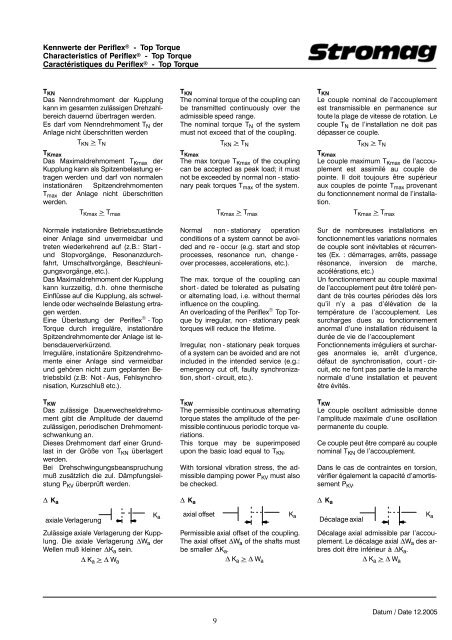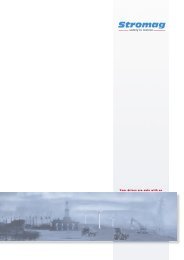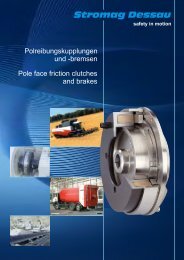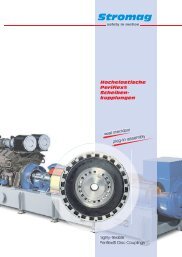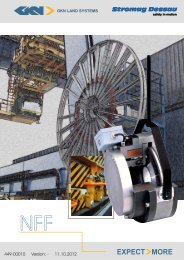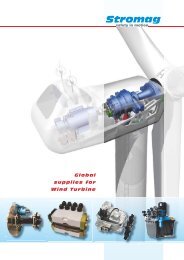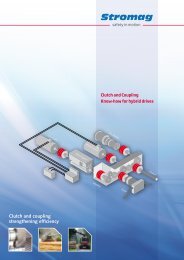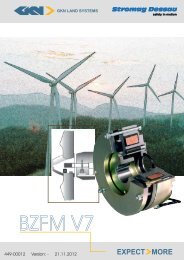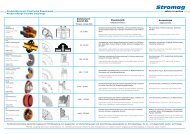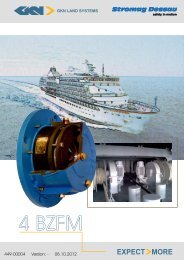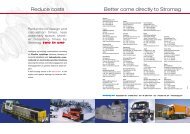PTT Periflex mehr Drehmoment und sicher couple élevé ... - Gkn.com
PTT Periflex mehr Drehmoment und sicher couple élevé ... - Gkn.com
PTT Periflex mehr Drehmoment und sicher couple élevé ... - Gkn.com
You also want an ePaper? Increase the reach of your titles
YUMPU automatically turns print PDFs into web optimized ePapers that Google loves.
Kennwerte der <strong>Periflex</strong>® − Top Torque<br />
Characteristics of <strong>Periflex</strong>® − Top Torque<br />
Caractéristiques du <strong>Periflex</strong>® − Top Torque<br />
TKN Das Nenndrehmoment der Kupplung<br />
kann im gesamten zulässigen Drehzahl−<br />
bereich dauernd übertragen werden.<br />
Es darf vom Nenndrehmoment TN der<br />
Anlage nicht überschritten werden<br />
TKN > TN TKmax Das Maximaldrehmoment TKmax der<br />
Kupplung kann als Spitzenbelastung er−<br />
tragen werden <strong>und</strong> darf von normalen<br />
instationären Spitzendrehmomenten<br />
Tmax der Anlage nicht überschritten<br />
werden.<br />
TKmax > Tmax Normale instationäre Betriebszustände<br />
einer Anlage sind unvermeidbar <strong>und</strong><br />
treten wiederkehrend auf (z.B.: Start −<br />
<strong>und</strong> Stopvorgänge, Resonanzdurch−<br />
fahrt, Umschaltvorgänge, Beschleuni−<br />
gungsvorgänge, etc.).<br />
Das Maximaldrehmoment der Kupplung<br />
kann kurzzeitig, d.h. ohne thermische<br />
Einflüsse auf die Kupplung, als schwel−<br />
lende oder wechselnde Belastung ertra−<br />
gen werden.<br />
Eine Überlastung der <strong>Periflex</strong> � −Top<br />
Torque durch irreguläre, instationäre<br />
Spitzendrehmomente der Anlage ist le−<br />
bensdauerverkürzend.<br />
Irreguläre, instationäre Spitzendrehmo−<br />
mente einer Anlage sind vermeidbar<br />
<strong>und</strong> gehören nicht zum geplanten Be−<br />
triebsbild (z.B: Not − Aus, Fehlsynchro−<br />
nisation, Kurzschluß etc.).<br />
T KW<br />
Das zulässige Dauerwechseldrehmo−<br />
ment gibt die Amplitude der dauernd<br />
zulässigen, periodischen <strong>Drehmoment</strong>−<br />
schwankung an.<br />
Dieses <strong>Drehmoment</strong> darf einer Gr<strong>und</strong>−<br />
last in der Größe von T KN überlagert<br />
werden.<br />
Bei Drehschwingungsbeanspruchung<br />
muß zusätzlich die zul. Dämpfungslei−<br />
stung P KV überprüft werden.<br />
� K a<br />
axiale Verlagerung<br />
K a<br />
Zulässige axiale Verlagerung der Kupp−<br />
lung. Die axiale Verlagerung �Wa der<br />
Wellen muß kleiner �Ka sein.<br />
� Ka > � Wa TKN The nominal torque of the coupling can<br />
be transmitted continuously over the<br />
admissible speed range.<br />
The nominal torque TN of the system<br />
must not exceed that of the coupling.<br />
TKN > TN TKmax The max torque TKmax of the coupling<br />
can be accepted as peak load; it must<br />
not be exceeded by normal non − statio−<br />
nary peak torques Tmax of the system.<br />
9<br />
T Kmax > T max<br />
Normal non − stationary operation<br />
conditions of a system cannot be avoi−<br />
ded and re − occur (e.g. start and stop<br />
processes, resonance run, change −<br />
over processes, accelerations, etc.).<br />
The max. torque of the coupling can<br />
short − dated be tolerated as pulsating<br />
or alternating load, i.e. without thermal<br />
influence on the coupling.<br />
An overloading of the <strong>Periflex</strong> � Top Tor−<br />
que by irregular, non − stationary peak<br />
torques will reduce the lifetime.<br />
Irregular, non − stationary peak torques<br />
of a system can be avoided and are not<br />
included in the intended service (e.g.:<br />
emergency cut off, faulty synchroniza−<br />
tion, short − circuit, etc.).<br />
T KW<br />
The permissible continuous alternating<br />
torque states the amplitude of the per−<br />
missible continuous periodic torque va−<br />
riations.<br />
This torque may be superimposed<br />
upon the basic load equal to T KN.<br />
With torsional vibration stress, the ad−<br />
missible damping power P KV must also<br />
be checked.<br />
� K a<br />
axial offset K a<br />
Permissible axial offset of the coupling.<br />
The axial offset �W a of the shafts must<br />
be smaller �K a.<br />
� K a > � W a<br />
TKN Le <strong>couple</strong> nominal de l’ac<strong>couple</strong>ment<br />
est transmissible en permanence sur<br />
toute la plage de vitesse de rotation. Le<br />
<strong>couple</strong> TN de l’installation ne doit pas<br />
dépasser ce <strong>couple</strong>.<br />
TKN > TN TKmax Le <strong>couple</strong> maximum TKmax de l’accou−<br />
plement est assimilé au <strong>couple</strong> de<br />
pointe. Il doit toujours être supérieur<br />
aux <strong>couple</strong>s de pointe Tmax provenant<br />
du fonctionnement normal de l’installa−<br />
tion.<br />
TKmax > Tmax Sur de nombreuses installations en<br />
fonctionnement les variations normales<br />
de <strong>couple</strong> sont inévitables et récurren−<br />
tes (Ex. : démarrages, arrêts, passage<br />
résonance, inversion de marche,<br />
accélérations, etc.)<br />
Un fonctionnement au <strong>couple</strong> maximal<br />
de l’ac<strong>couple</strong>ment peut être toléré pen−<br />
dant de très courtes périodes dès lors<br />
qu’il n’y a pas d’élévation de la<br />
température de l’ac<strong>couple</strong>ment. Les<br />
surcharges dues au fonctionnement<br />
anormal d’une installation réduisent la<br />
durée de vie de l’ac<strong>couple</strong>ment<br />
Fonctionnements irréguliers et surchar−<br />
ges anormales ie, arrêt d’urgence,<br />
défaut de synchronisation, court − cir−<br />
cuit, etc ne font pas partie de la marche<br />
normale d’une installation et peuvent<br />
être évités.<br />
T KW<br />
Le <strong>couple</strong> oscillant admissible donne<br />
l’amplitude maximale d’une oscillation<br />
permanente du <strong>couple</strong>.<br />
Ce <strong>couple</strong> peut être <strong>com</strong>paré au <strong>couple</strong><br />
nominal T KN de l’ac<strong>couple</strong>ment.<br />
Dans le cas de contraintes en torsion,<br />
vérifier également la capacité d’amortis−<br />
sement P KV.<br />
� K a<br />
Décalage axial<br />
K a<br />
Décalage axial admissible par l’accou−<br />
plement. Le décalage axial �W a des ar−<br />
bres doit être inférieur à �K a.<br />
� K a > � W a<br />
Datum / Date 12.2005


